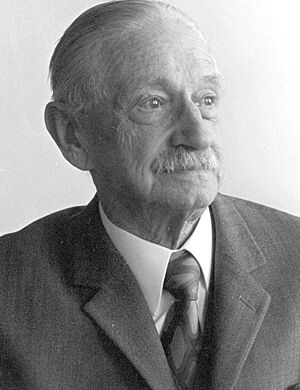Walther Meissner facts for kids
Quick facts for kids
Fritz Walther Meissner
|
|
|---|---|

Meissner, c. 1968
|
|
| Born | 16 December 1882 |
| Died | 16 November 1974 (aged 91) |
| Nationality | German |
| Alma mater | Technical University of Munich |
| Known for | Meissner effect Holm-Meissner effect |
| Awards | Simon Memorial Prize (1970) |
| Scientific career | |
| Fields | Physicist Superconductivity |
| Institutions | Physikalisch-Technische Bundesanstalt Technical University of Munich |
| Doctoral advisor | Max Planck |
Fritz Walther Meißner (pronounced My-sner) was a German scientist who studied physics. He was born on December 16, 1882, in Berlin, Germany, and passed away on November 16, 1974, in Munich. Meißner is famous for his work with very cold temperatures and for discovering something called the Meissner effect.
Contents
Early Life and Education
Walther Meißner was born in Berlin to his parents, Waldemar Meißner and Johanna Greger. He was very interested in how things work, so he decided to study both mechanical engineering and physics. He went to the Technical University of Berlin to learn more.
Learning from a Master
While he was studying, Meißner had a very important teacher named Max Planck. Max Planck was a famous physicist who won the Nobel Prize. Learning from someone like Planck helped Meißner become a great scientist himself.
Discoveries and Career
After finishing his studies, Meißner started working at the Physikalisch-Technische Bundesanstalt in Berlin. This is a big research institute in Germany.
Making Things Super Cold
From 1922 to 1925, Meißner worked on building a special machine. This machine was a "helium-liquifier." It could make helium so cold that it turned into a liquid! At the time, it was the third largest machine of its kind in the world. This was a big step in studying materials at extremely low temperatures.
The Meissner Effect
In 1933, Meißner made his most famous discovery, which is now called the Meissner effect. He found that when certain materials become "superconductors," they push out any magnetic fields around them.
What is a Superconductor?
A superconductor is a material that can carry electricity with absolutely no resistance when it's cooled down to a very low temperature. Imagine a super-fast highway for electricity!
How the Meissner Effect Works
When a material becomes a superconductor, it acts like a perfect shield against magnets. If you put a magnet near a superconductor, the superconductor will push the magnetic field away. This is why superconductors can sometimes make magnets float in the air!
Becoming a Professor
One year after his big discovery, Meißner became a professor at the Technical University of Munich. He taught "technical physics," which is about how physics can be used in engineering and technology.
Later Life and Legacy
After World War II, Walther Meißner continued his important work in science.
Leading Research
He became the president of the Bavarian Academy of Sciences and Humanities. In 1946, he was put in charge of a new group called the "low temperature research commission." This group studied materials at very cold temperatures. Their first laboratories were in a place called Herrsching am Ammersee. Later, in 1965, the labs moved to Garching.
Walther Meißner passed away in Munich in 1974, but his discoveries, especially the Meissner effect, are still very important in physics today. Scientists continue to study superconductors and their amazing properties.

